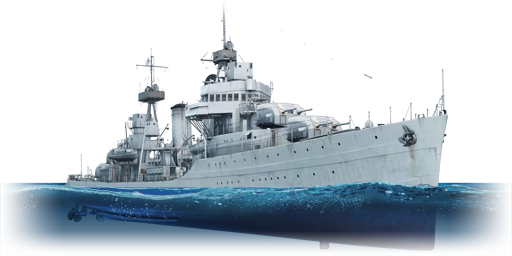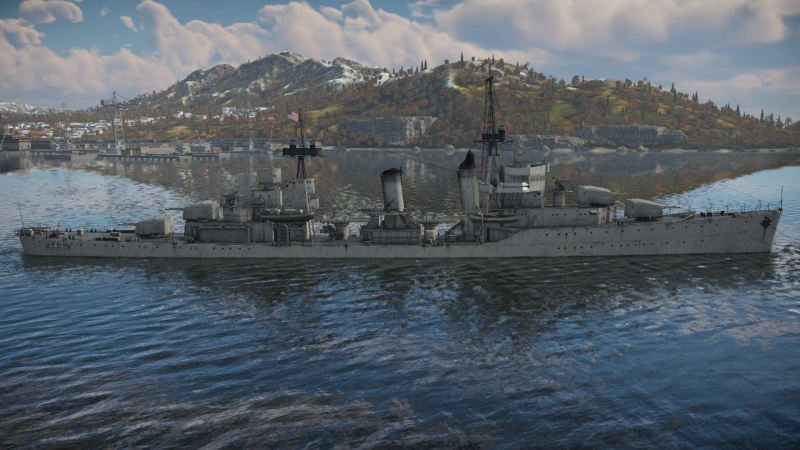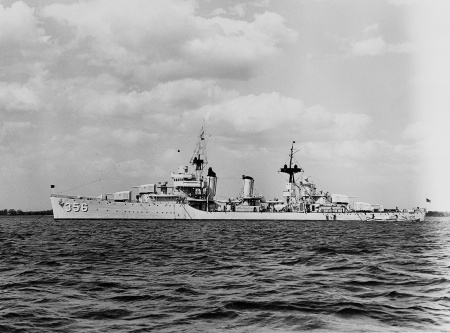Difference between revisions of "USS Porter"
(Updated format) |
Bonisducks (talk | contribs) (→History) (Tag: Visual edit) |
||
| Line 76: | Line 76: | ||
== History == | == History == | ||
| − | + | <!-- Describe the history of the creation and combat usage of the ship in more detail than in the introduction. If the historical reference turns out to be too long, take it to a separate article, taking a link to the article about the ship and adding a block "/History" (example: https://wiki.warthunder.com/(Ship-name)/History) and add a link to it here using the main template. Be sure to reference text and sources by using <ref></ref>, as well as adding them at the end of the article with <references />. This section may also include the ship's dev blog entry (if applicable) and the in-game encyclopedia description (under === In-game description ===, also if applicable). -->[[File:USS Porter 1939.jpg|thumb|450x450px|USS Porter off of Yorktown, Virginia in 1939. Note the cruiser-like appearance of her superstructure.]] | |
| + | The USS porter (DD-356) was the lead ship of her class of large destroyers built for the United States Navy before the Second World War. Designed as a destroyer leader to lead large groups of destroyers in combat, the Porter was built with a substantial main armament making her one of the most heavily-armed destroyers of her time. Porter saw some service during the Second World War in the pacific theatre, and was eventually scuttled after being torpedoed at the Battle of the Santa Cruz Islands. | ||
| + | |||
| + | === Design and development === | ||
| + | During the interwar period, the United States Navy built a number of large destroyers, or destroyer leaders, designed to lead destroyer flotillas in future conflicts. The first of these classes, the Porter class, was designed and built in the early 1930s. Porter was the lead ship of this class, and was laid down in December of 1933. She was launched two years later in December of 1935, and commissioned by August of 1936. | ||
| + | |||
| + | Porter carried a main armament of eight 5-inch (127 mm) guns in four dual mounts - this was an exceptionally-heavy armament for a destroyer, matched only by her successor class, the [[Somers (DD-381)|Somers]]. Her anti-aircraft armament was extremely weak, with just two quadruple 28 mm (1.1 inch) Chicago Piano anti-aircraft mounts and two 12.7 mm (0.5 inch) AN/M2 machine guns. Porter had a massive engine block delivering 50 000 shaft horsepower, allowing her to reach a maximum speed of 35 knots. However, unlike the succeeding Somers class, Porter had two funnels, limiting her to eight 533 mm torpedo tubes in two quad mounts. She had a crew of 194 officers and men. | ||
| + | |||
| + | === Operational History === | ||
| + | After her commissioning, the Porter embarked on a shakedown cruise to Northern Europe and St. John’s, Newfoundland. In August of 1937, she transferred to the Pacific fleet and was based out of San Diego, where she operated until the start of the Second World War. Through a stroke of luck, the Porter was not at Pearl Harbour on the day of the attack, having left port two days earlier. She then spent the next few months in training, before joining TF 16 heading towards the Solomon islands. Upon arriving at the Solomons, the American carrier force engaged Japanese naval units in an engagement to be known as the Battle of Santa Cruz. In the ensuing action, Porter was torpedoed and eventually scuttled by the destroyer Shaw. The origin of the torpedo is not clear; however, a Japanese submarine is likely the culprit. Porter earned one battle star for her service during the Second World War. | ||
== Media == | == Media == | ||
| Line 89: | Line 98: | ||
== External links == | == External links == | ||
| − | + | <!-- Paste links to sources and external resources, such as: | |
| + | |||
| + | topic on the official game forum; | ||
| + | encyclopedia page on the ship; | ||
| + | other literature. --> | ||
| + | === References === | ||
| − | * | + | * Helgason, G. (1995). USS Porter. Retrieved January 26, 2021, from <nowiki>https://uboat.net/allies/warships/ship/5149.html</nowiki> |
| − | * | + | * Navy History and Heritage Command. (2019, August 9). Porter III (DD-356). Retrieved January 26, 2021, from <nowiki>https://www.history.navy.mil/research/histories/ship-histories/danfs/p/porter-iii.html</nowiki> |
| − | |||
{{ShipManufacturer New York Shipbuilding Corp.}} | {{ShipManufacturer New York Shipbuilding Corp.}} | ||
{{USA destroyers}} | {{USA destroyers}} | ||
Revision as of 20:06, 26 January 2021
Contents
Description
The Porter-class, USS Porter (DD-356), 1941 is a rank III American destroyer with a battle rating of 5.0 (AB/RB/SB). It was introduced in Update 1.95 "Northern Wind".
General info
Survivability and armour
The Porter is equipped with anti-frag armor, but this only helps against HE, and is useless against shells from most cruisers. That being said, given its large crew size (for a destroyer) and anti-frag protection, Porter can serve as a destroyer leader, and (briefly) tank shells whilst the rest of its team follows up behind. The Porters turrets are somewhat protected from HMG and auto cannon fire, but are also large and prone to being disabled by dedicated artillery pieces above 76mm, though you do have eight of them. The ship also has a row torpedo tubes which serve as an easy to see ammo rack to detonate, if torpedoes are brought along.
Mobility
The ability to steam above 60 km/h, makes the Porter a very fast vessel, at the cost of some turning time.
| Mobility Characteristics | |||
|---|---|---|---|
| Game Mode | Upgrade Status | Maximum Speed (km/h) | |
| Forward | Reverse | ||
| AB | |||
| Upgraded | 84 | 35 | |
| RB/SB | |||
| Upgraded | 69 | 29 | |
Modifications and economy
Armament
Primary armament
Eight 5-inch cannons, makes the Porter one of the most dangerous destroyers in the game. That being said, due to the turrets being of a pre-war design, they have a relatively slow reaction time, as they turn rather slowly. Hence the Porter's require a player to think of precisely when and where an enemy will come from. The rate of fire can easily be cut to under twenty rounds per minute, but the guns have a poor arc and velocity, and thus excel in close to medium range engagements.
Secondary armament
The Porter has only two 1 inch AA guns. They are slow to traverse, and slow to fire, and you are better off using your main cannons with timed fuse shells for any really AA damage. Still they do serve as a deterrent and early warning system
Anti-aircraft armament
With only two 12.5 machine guns, some PT boats have better dedicated AA weaponry. Regardless they can still deter some planes, but cannot cover the front of the ship at all
Additional armament
With 15 torpedoes, with a decent range and speed, the Porter can be a torpedo boat, but aside from serving as an ammo rack, in game, the high speed and rough terrain makes carrying torpedoes a very situational weapon, and one that largely shines in Naval EC
Usage in battles
Destroyer Hunter
With double the guns of almost every destroyer around its BR, the Porter is a great anti destroyer hunter, a role it should stick to in an up-tier givens its low caliber main battery. Due to its large size and poor lack luster armor (which only helps against HE fire), the Porter should refrain from a cruiser gun duel, and instead cap points or cover more protected or faster allies in the shallow and narrow areas around caps.
Pros and cons
Pros:
- 8 x 5-inch dual purpose guns give it excellent firepower
- Decent rate of fire
Cons:
- AA power is lacklustre due to only 2 x 12.7 mm AN-M2 Browning machine guns and 2 x 1.1"/75 calibre guns.
- The turrets lack any true armour making them vulnerable, much like its successor, USS Somers
- Has a small crew size of 194
History
The USS porter (DD-356) was the lead ship of her class of large destroyers built for the United States Navy before the Second World War. Designed as a destroyer leader to lead large groups of destroyers in combat, the Porter was built with a substantial main armament making her one of the most heavily-armed destroyers of her time. Porter saw some service during the Second World War in the pacific theatre, and was eventually scuttled after being torpedoed at the Battle of the Santa Cruz Islands.
Design and development
During the interwar period, the United States Navy built a number of large destroyers, or destroyer leaders, designed to lead destroyer flotillas in future conflicts. The first of these classes, the Porter class, was designed and built in the early 1930s. Porter was the lead ship of this class, and was laid down in December of 1933. She was launched two years later in December of 1935, and commissioned by August of 1936.
Porter carried a main armament of eight 5-inch (127 mm) guns in four dual mounts - this was an exceptionally-heavy armament for a destroyer, matched only by her successor class, the Somers. Her anti-aircraft armament was extremely weak, with just two quadruple 28 mm (1.1 inch) Chicago Piano anti-aircraft mounts and two 12.7 mm (0.5 inch) AN/M2 machine guns. Porter had a massive engine block delivering 50 000 shaft horsepower, allowing her to reach a maximum speed of 35 knots. However, unlike the succeeding Somers class, Porter had two funnels, limiting her to eight 533 mm torpedo tubes in two quad mounts. She had a crew of 194 officers and men.
Operational History
After her commissioning, the Porter embarked on a shakedown cruise to Northern Europe and St. John’s, Newfoundland. In August of 1937, she transferred to the Pacific fleet and was based out of San Diego, where she operated until the start of the Second World War. Through a stroke of luck, the Porter was not at Pearl Harbour on the day of the attack, having left port two days earlier. She then spent the next few months in training, before joining TF 16 heading towards the Solomon islands. Upon arriving at the Solomons, the American carrier force engaged Japanese naval units in an engagement to be known as the Battle of Santa Cruz. In the ensuing action, Porter was torpedoed and eventually scuttled by the destroyer Shaw. The origin of the torpedo is not clear; however, a Japanese submarine is likely the culprit. Porter earned one battle star for her service during the Second World War.
Media
See also
Links to articles on the War Thunder Wiki that you think will be useful for the reader, for example:
- reference to the series of the ship;
- links to approximate analogues of other nations and research trees.
External links
References
- Helgason, G. (1995). USS Porter. Retrieved January 26, 2021, from https://uboat.net/allies/warships/ship/5149.html
- Navy History and Heritage Command. (2019, August 9). Porter III (DD-356). Retrieved January 26, 2021, from https://www.history.navy.mil/research/histories/ship-histories/danfs/p/porter-iii.html
| New York Shipbuilding Corporation | |
|---|---|
| Gun Destroyers (DD) | |
| Porter-class | USS Porter |
| Cruiser, Light (CL) | |
| Cleveland-class | USS Cleveland |
| Fargo-class | USS Fargo |
| Worcester-class | USS Roanoke |
| Large Cruisers (CB) | |
| Alaska-class | USS Alaska |
| Battleships (BB) | |
| Wyoming-class | USS Arkansas |
| USA destroyers | |
|---|---|
| Clemson-class | USS Welborn C. Wood · USS Barker · USS Litchfield |
| Farragut-class | USS Aylwin |
| Porter-class | USS Porter · USS Phelps · USS Moffett |
| Somers-class | USS Somers · USS Davis |
| Fletcher-class | USS Fletcher · USS Bennion · USS Cowell |
| Allen M. Sumner-class | USS Sumner |
| Gearing-class | USS Gearing · USS Frank Knox |
| Mitscher-class | USS Mitscher · USS Wilkinson |






